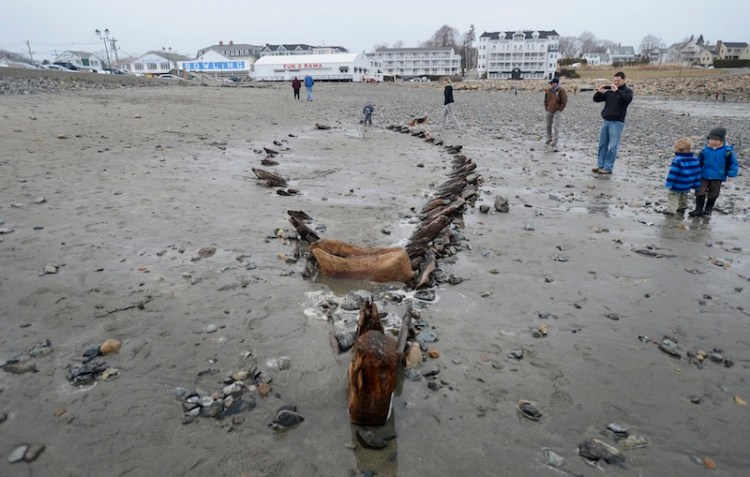Rough seas that washed sand away from the beaches of York last weekend left behind a surprising sight for local residents: the remnants of a shipwreck.
Although the skeleton of the ship, believed to be at least 160 years old, has appeared from time to time on Short Sands Beach, little is known about the boat or how it ended up buried in the sand.
What’s left of the wooden hull – catalogued by the state as the Short Sands Beach Wreck – made news in the 1950s after being exposed by a storm. It last appeared after the powerful Patriots Day storm in 2007.

This image from Howard’s Encyclopedia of 1788 shows a fully rigged Colonial sloop, the same general type of vessel that wrecked long ago on Short Sands beach in York and was exposed by last week’s storm. Image provided by Maine Maritime Museum.
“It always seems to stir the town up when it does arrive,” said Tim Ellis, a lifelong resident whose mother brought a historian to York in 1958 to look at the wreck.
The sight of the timbers sticking out of the sand drew photographers and curious beachcombers to the wreck at low tide during the weekend and Monday. It remains to be seen how long it will take the waves to push sand back over the wreck, and when it will surface again.
The 51-foot-long hull is believed to be from a late colonial or early post-colonial sloop, which means it would date from 1750 to 1850, said Leith Smith, a historical archaeologist with the Maine Preservation Commission.
A sloop is a sailing vessel with a single mast. Such vessels were common along Maine’s coast and were used for fishing and for hauling cargo such as dried fish or lumber.
Although the wreck in York appears only occasionally, it is “quite common” to find ship remnants on beaches in Maine, Smith said. There are 1,595 known shipwrecks along Maine’s coast, including 66 in York and its coastal waters.
“There are old ships that get pulled up (on a beach) once the ship has ended its useful life. They kind of rot in place,” Smith said.
Most shipwrecks in Maine aren’t visible or, as with the Short Sands Beach Wreck, are seen only after being uncovered by major storms, he said.
The Maine Preservation Commission maintains an inventory of historic sites that includes shipwrecks. The inventory includes measured drawings of the ships to document as much information as possible, Smith said.
Shipwrecks are usually left where they lie because moving and preserving them is “hugely expensive” and only limited information can be gleaned from the process, Smith said.
“Trying to preserve timbers like that is a long process and quite expensive,” he said. “It’s often best just to leave them in the ground. When it’s covered, it’s fairly well preserved.”
Eileen Sewall, program coordinator for the Museums of Old York, said little is known locally about the boat at Short Sands, despite the town’s well-documented history of shipwrecks.

Timbers from a ship’s hull poke out of the sand in York on Monday.
Well-known shipwrecks along York’s coast include the Nottingham Galley, the subject of the book “Boone Island” by Kenneth Roberts.
In a column published in The York Weekly in 1994, historian Peter Moore recounted the first widely documented sighting of the Short Sands boat.
The hull first became visible after a nor’easter washed 4 feet of sand away from Short Sands Beach in early April 1958. Locals thought it could be a Viking ship or a “pinky,” a type of sailing vessel with a pointed, or pinched, stern that was common along the Maine coast in the 18th and 19th centuries.
Back in 1958, resident Ruth Ellis invited historian Edward Rowe Snow to York to investigate the hull, which was partially covered by sand by the time he arrived. He met with local fishermen and marine hobbyists at the Ellis Insurance Agency for interviews about the boat.
Ultimately, most people involved in the discussions agreed that the boat was a pinky, Moore wrote.
“They based their conclusions on the fact that pinky boats sailed in and out of the Cape Neddick River and that both wood and iron spikes were used to hold the hull together,” Moore wrote.
Tim Ellis, the son of Ruth Ellis and the current owner of the insurance agency, was a young child when the boat was found and has only vague memories of seeing it on the beach.
“It was very unusual to find a hull, especially of that size,” Ellis said.
York police Sgt. Martin Doherty said people should stay off the hull. The town prohibits people from taking pieces of the boat — or the beach in general — as souvenirs.
“We don’t permit people to remove anything whatsoever from the beach, but we’ve never really had a problem with it,” Doherty said.
Gillian Graham can be contacted at 791-6315 or at:
ggraham@pressherald.com
Twitter: grahamgillian
Send questions/comments to the editors.




Success. Please wait for the page to reload. If the page does not reload within 5 seconds, please refresh the page.
Enter your email and password to access comments.
Hi, to comment on stories you must . This profile is in addition to your subscription and website login.
Already have a commenting profile? .
Invalid username/password.
Please check your email to confirm and complete your registration.
Only subscribers are eligible to post comments. Please subscribe or login first for digital access. Here’s why.
Use the form below to reset your password. When you've submitted your account email, we will send an email with a reset code.